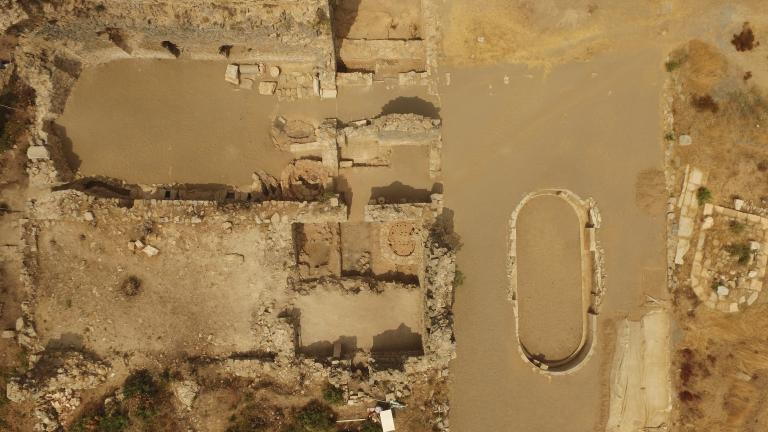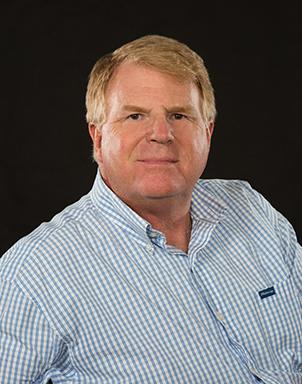
Hoff's excavation in Turkey yields light industrial finds
calendar icon20 Sep 2017 user iconBy Kathe C. Andersen

Lincoln, Neb.—Three additional kilns were uncovered this summer at the Antiochia at Cragum excavation in Turkey this summer, bringing the total to six kilns. The kilns, along with a previously uncovered glass manufacturing workshop, all found in the bath house area of the site, indicates the area became light industrial in nature during the late Roman Empire (5th to 7th century A.D.).
Since 2005, University of Nebraska–Lincoln Hixson-Lied Professor of Art History Michael Hoff’s team has been excavating the remains of the ancient city of Antiochia ad Cragum on the southern Turkish coast. Antiochus IV of Commagene, a client-king of Rome, founded the city in the middle of the 1st century A.D.
Hoff, who is the director of the excavation, said it’s not surprising this area became repurposed later in its history from a bath house to a light industrial center.
“The bath, we now know, dates to the second half of the first century A.D., so it was among one of the earliest public buildings constructed after the site was founded about A.D. 50,” he said. “Like anything, no building lasts forever. So even these buildings can’t serve the same function permanently. We have become aware that based on historical research at the site that the city was invaded by Persians in the year 260, so that would have given this bath house about 200 years of life. We don’t know for sure the Persians destroyed the building, but it’s possible. It was probably damaged and repaired.”
Roman baths, Hoff said, are always organized in three sections—going from cold to warm to hot. The largest room is usually the cold room.
“It’s that way in most every bath from Arabia to Britain,” Hoff said.
As they began excavating down, their goal was to find the heating system for the bath, which they did.
“We found a few fragments of the original suspension system that raised the floor to allow the hot gases to circulate underneath,” Hoff said. “But what happened was that the floor itself was destroyed, and these kilns were constructed about halfway down so, to us, that sounds like the building was already out of commission. And if they’re building a kiln inside of it, which needs a lot of space to allow the smoke to escape, we think that the ceiling was probably partly gone.”
Hoff said the light industrial use probably dates to late Roman or early Byzantine period, which is 5th to 7th centuries A.D.
At this point, they have only excavated about 40 percent of this bath building.
“We have already found six kilns and one glass workshop, so who knows what else we are going to find,” Hoff said. “But this is a pretty massive light industrial center.”
Hoff is excited about finding these kilns because of what else they might learn from discovering them.
“Ceramics is the ‘stuff’ of archaeology because we use it for so much other information than simply dating,” Hoff said. “It also helps us understand the trade patterns. It helps us understand what is being made, what is being traded, what food, what wine, what oils and things like that, so it’s a really important part of any excavation.”
The team brought in a ceramics expert this year, Dr. Asena Kizilarslanoglu from Ahi Evran University in Turkey to research the growing ceramics collection, especially the information gleaned from the newly-discovered ceramic kilns.
“On some of these kilns that we found we can find shards of the wasters that were made,” Hoff said. “So our ceramics expert can identify that fabric, so she can go around to other sites in the Mediterranean and recognize those shards from our kiln. This is what’s important to establish trade patterns so we understand where the pots are going that are made at our site.”
Hoff and his team also cleared more of the Bouleuterion or city council-house and the Odeon.
“Last year we had cleared 75 percent, and now it’s completely cleared except maybe three percent,” Hoff said. “But we now can create the entire plan of it.”
Last year, they found some iron bars that were brackets that supported the grandstand seating.
“This year we found another bracket,” Hoff said. “But the cool thing was that it still had wood attached to it.”
They sent the wood to a laboratory in Turkey for Carbon-14 dating analysis, and the early results indicate that it dates between A.D. 75 and 175.
“That’s when the wood was cut,” Hoff said. “How long did it take before it was cut into planks? Probably pretty quickly. How long did it last as somebody’s seating? Probably a generation or so before it was replaced. But it gives us a general understanding of the construction of this structure.”
Tim Howe, a professor of history at St. Olaf University, also was on the site this summer working on a late Roman church site that dates to the 5th-7th centuries. He worked in the crypt.
“Inside the crypt, he found lots of lamps, and he found part of the chancel screen,” Hoff said.
Hoff and Howe also did a survey of some of the standing architecture up on the acropolis.
“We found an inscription, and it’s really cool,” Hoff said. “Because it’s the very first known inscription that we have that has the name of the city inscribed on it.”
The Latin name of the city, Antiochia ad Cragum, refers to Antioch “on the cliffs.
“But interestingly, the name in Greek doesn’t refer to cliffs at all,” Hoff said. “Rather, it refers to its location on the sea, Antiochia tis Paralia. After Tim left, I found another inscription that had the same formula on it. It’s also the name that’s given on the coinage. So we think the most common name for this city was actually Antioch on the Sea.”
Even after 12 years of excavating, Hoff said he still gets excited by what he discovers each season.
“I always get excited by it,” he said. “But, you know, it is a lot of hard work, especially to go right from when school ends to Turkey and then when we end, I go right back into teaching. So you don’t have a whole lot of time to smell the flowers or process everything. But of course it’s fun or I wouldn’t be doing it.”